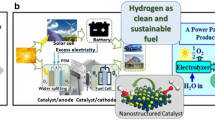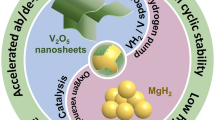Abstract
Currently, the conventional halide synthesis method of preparing hafnium alkoxides [Hf(OR)4, R is an alkyl] has problems of inefficiency, a heavy CO2 emission footprint, and substantial solid and gas waste, which severely hinders its wide deployment. Herein, we propose an electrodissolution-coupled Hf(OR)4 synthesis system using an alcohol solvent and Hf metal as feedstock for the efficient, low-carbon and waste-free electro-synthesis of Hf(OR)4. The electrochemical behavior of the tetraethylammonium-hydrogen sulfate (Et4NHSO4)-based EHS process is investigated by cyclic voltammetry, linear sweep voltammetry, Tafel, and electrochemical impedance spectroscopy, complemented with SEM observation. The anodic hafnium dissolution/corrosion occurs inside the passive film while the cathodic ethanol dehydrogenation occurs in a two-stage pathway. Tafel extrapolation and numerical fitting analysis acquires important kinetics parameters, such as corrosion current density, exchange current density, and apparent activation energy as well as solution, polarization and “Warburg” resistances, etc. This work can provide theoretical guidance for the efficient operation of EHS.








Similar content being viewed by others
References
R.G. Gordon, J. Becker, D. Hausmann, and S. Suh, Chem. Mater. 13, 2463. https://doi.org/10.1021/cm010145k (2001).
C. Mui and C.B. Musgrave, J. Phys. Chem. B 108, 15150. https://doi.org/10.1021/jp037507r (2004).
J.A. del Alamo, Nature 479, 317. https://doi.org/10.1038/nature10677 (2011).
H. Ko, K. Takei, R. Kapadia, S. Chuang, H. Fang, P.W. Leu, K. Ganapathi, E. Plis, H.S. Kim, S.-Y. Chen, M. Madsen, A.C. Ford, Y.-L. Chueh, S. Krishna, S. Salahuddin, and A. Javey, Nature 468, 286. https://doi.org/10.1038/nature09541 (2010).
M. Leskelä and M. Ritala, Thin Solid Films 409, 138. https://doi.org/10.1016/S0040-6090(02)00117-7 (2002).
M.J. Mleczko, C. Zhang, H.R. Lee, H.-H. Kuo, B. Magyari-Köpe, R.G. Moore, Z.-X. Shen, I.R. Fisher, Y. Nishi, and E. Pop, Sci. Adv. 3, e1700481. https://doi.org/10.1126/sciadv.1700481 (2017).
Y. Widjaja and C.B. Musgrave, Appl. Phys. Lett. 81, 304. https://doi.org/10.1063/1.1490415 (2002).
G.D. Wilk, R.M. Wallace, and J.M. Anthony, J. Appl. Phys. 89, 5243. https://doi.org/10.1063/1.1361065 (2001).
D.M. Hausmann, E. Kim, J. Becker, and R.G. Gordon, Chem. Mater. 14, 4350. https://doi.org/10.1021/cm020357x (2002).
V. Miikkulainen, M. Leskelä, M. Ritala, and R.L. Puurunen, J. Appl. Phys. 113, 021301. https://doi.org/10.1063/1.4757907 (2013).
D. Bradley, R.C. Mehrotra, I. Rothwell, and A. Singh, Alkoxo and Aryloxo Derivatives of Metals (Elsevier, Amsterdam, 2001), pp 383–443.
Y. Yuan and A. Lei, Nat. Commun. 11, 802. https://doi.org/10.1038/s41467-020-14322-z (2020).
C. Wang, K. Jiang, T.W. Jones, S. Yang, H. Yu, P. Feron, and K. Li, Chem. Eng. J. 427, 131981. https://doi.org/10.1016/j.cej.2021.131981 (2022).
R. Sharifian, R. Wagterveld, I. Digdaya, C. Xiang, and D. Vermaas, Energy Environ. Sci. 14, 781. (2021).
M. Van Geem Kevin, V. Galvita Vladimir, and B. Marin Guy, Science 364, 734. https://doi.org/10.1126/science.aax5179 (2019).
H.-P. Yang, S.-H. Yang, Y.-N. Cai, G.-F. Hou, J.-Y. Xia, and M.-T. Tang, Trans. Nonferrous Met. Soc. China 21, 179. https://doi.org/10.1016/S1003-6326(11)60696-1 (2011).
A.J. Bard and L.R. Faulkner, Electrochem. Methods 2, 580. (2001).
A. Popova, E. Sokolova, S. Raicheva, and M. Christov, Corros. Sci. 45, 33. https://doi.org/10.1016/S0010-938X(02)00072-0 (2003).
E.P. Kovsman, S.I. Andruseva, L.I. Solovjeva, V.I. Fedyaev, M.N. Adamova, and T.V. Rogova, J. Sol-Gel. Sci. Technol. 2, 61. https://doi.org/10.1007/BF00486214 (1994).
C. Wang, S. Yang, Y. Chen, Y. Wu, J. He, and C.-B. Tang, Trans. Nonferrous Met. Soc. China 27, 694. https://doi.org/10.1016/S1003-6326(17)60077-3 (2017).
I. Betova, M. Bojinov, P. Kinnunen, T. Laitinen, P. Pohjanne, and T. Saario, Electrochim. Acta 47, 2093. https://doi.org/10.1016/S0013-4686(02)00080-4 (2003).
W. Ye, Y. Li, and F. Wang, Electrochim. Acta 54, 1339. https://doi.org/10.1016/j.electacta.2008.08.073 (2009).
G. Song, Corros. Sci. 47, 1953. https://doi.org/10.1016/j.corsci.2004.09.007 (2005).
D.A. Aikens, J. Chem. Educ. 60, A25. https://doi.org/10.1021/ed060pA25.1 (1983).
C. Wang, S. Yang, Y. Chen, B. Wang, J. He, and C. Tang, RSC Adv. 5, 34580. https://doi.org/10.1039/C5RA02233A (2015).
J.R. Macdonald, Ann. Biomed. Eng. 20, 289. https://doi.org/10.1007/BF02368532 (1992).
C. Wang, S. Yang, and Y. Chen, J. Appl. Electrochem. 49, 539. https://doi.org/10.1007/s10800-019-01301-6 (2019).
Acknowledgements
This work was supported by the Science and Technology Innovation Program of Hunan Province (No.2021RC2002) and the Natural Science Foundation of China (No.51374254).
Author information
Authors and Affiliations
Corresponding author
Ethics declarations
Conflict of interest
The authors declare no competing interests.
Additional information
Publisher's Note
Springer Nature remains neutral with regard to jurisdictional claims in published maps and institutional affiliations.
Supplementary Information
Below is the link to the electronic supplementary material.
Rights and permissions
About this article
Cite this article
Li, S., Yang, S. & Wang, C. Electrochemical Behavior of Tetraethylammonium-Hydrogen Sulfate-Based Electrodissolution-Coupled Hafnium Alkoxide Synthesis. JOM 74, 3548–3556 (2022). https://doi.org/10.1007/s11837-022-05393-y
Received:
Accepted:
Published:
Issue Date:
DOI: https://doi.org/10.1007/s11837-022-05393-y




